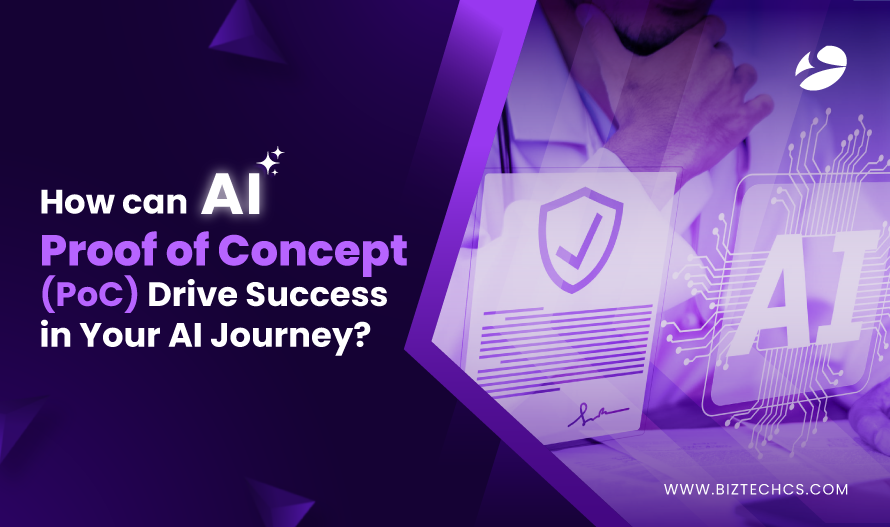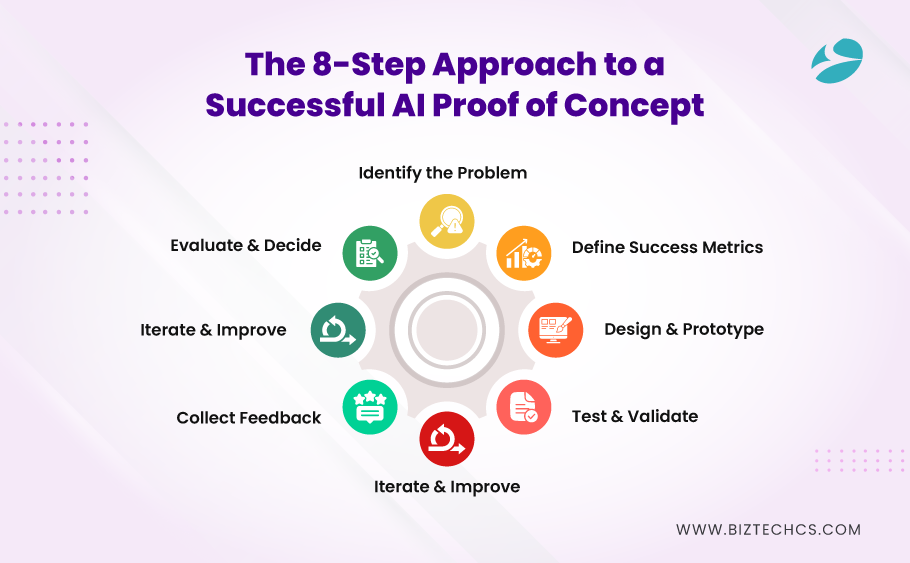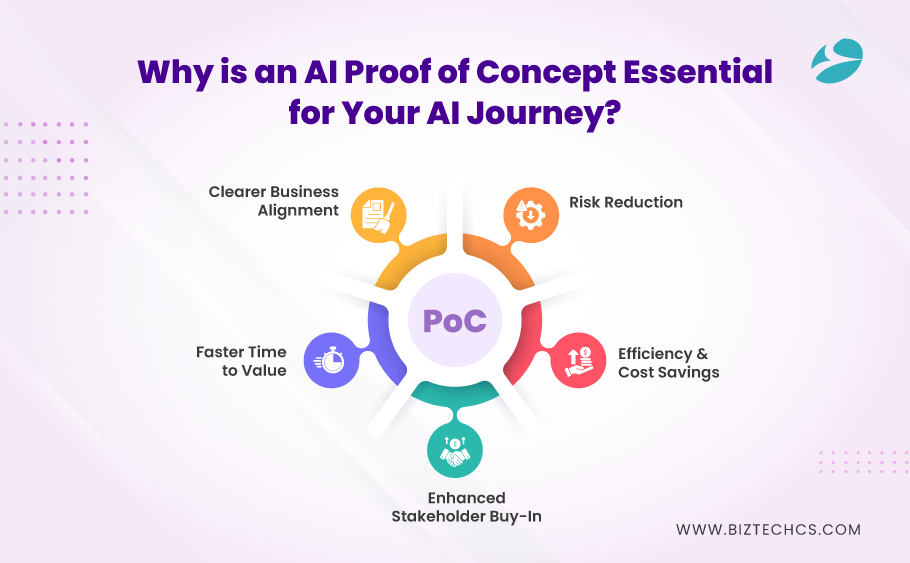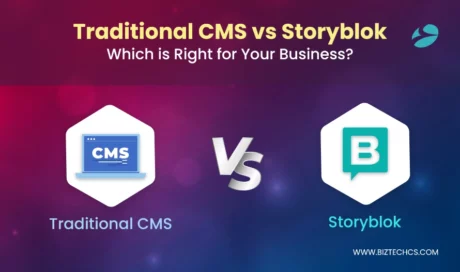How can AI Proof of Concept (PoC) Drive Success in Your AI Journey?
25 Apr, 2025
10 min read
25 Apr, 2025
10 min read
Table Of Content

Most organizations are pursuing artificial intelligence applications to enhance operational efficiency and decision-making processes. Nevertheless, converting an idea into execution is scarcely an easy affair. Common obstacles are unclear objectives and goals, insufficient data, and doubts about ROI. AI/ML development services can help overcome these hurdles by testing ideas on a smaller scale. It enables teams to see what may work before committing to larger investments.
Common obstacles are unclear objectives and goals, insufficient data, and doubts about ROI. An AI proof of concept may be an instrument to overcome these hurdles by testing ideas on a smaller scale. It enables teams to see what may work before committing to larger investments.
A good PoC will provide insights into value, cost of the PoC, and longer-term feasibility for AI implementation.
Research indicates that nearly 80% of AI projects are stalled at the pilot stage due to a lack of direction (source).
Therefore, a well-directed AI PoC is not only useful but necessary. With the right approach, an AI PoC reduces uncertainty and equips your AI journey with structure.
An AI proof-of-concept is a small-scale project designed to test the feasibility of an AI solution for a real-world business problem. It helps in determining whether to pursue this idea further. A PoC is neither a prototype nor a minimum viable product (MVP).
A prototype shows what a solution may look like; an MVP implements basic functionality. The AI PoC, on the other hand, is designed to demonstrate that the concept can be effective. The team’s objectives are to establish data readiness, technical fit, and expected outcomes.
For instance, AI can be used for cash flow forecasting or fraud detection by companies developing accounting software before deploying it for full-scale use. AI may also be harnessed for HR document management to automate resume screening. These small tests enable businesses to make informed and wise decisions about their next steps.
The AI PoC helps to create clarity before proceeding to scale solutions in any area. It’s a way to test the waters for AI solution approaches in semi-safe areas without the kind of massive investment or risk commonly associated with genuine implementation.
During the AI PoC, you can work through its scope, spot potential limitations, and validate the resolution’s compatibility with data. This concentrated approach ensures that your artificial intelligence PoC is aligned with genuine business objectives, thereby reducing the likelihood of rework later.

Begin with a well-defined and explicitly articulated business challenge. The proof of concept must address a genuine issue, not a hypothetical one. Get feedback from the people affected by the problem. Understand what’s broken, where the delays are, or what costs too much. A well-defined problem leads to a well-defined solution.
Determine early on how you would measure success. Apply criteria that are straightforward, measurable, and realistic. Avoid vague goals; be realistic with what can be monitored in the short term. The metrics can be related to time, accuracy, costs saved, or errors reduced. These numbers will indicate whether the concept succeeded or not later.
Build a basic version of the solution, without any additional features. Should be limited to proving the core idea; develop a flexible design for further modifications. Focus on the single aspect of the process that the AI runs or augments. Don’t build non-testing features.
Run the prototype in a controlled environment. Compare outputs with the performance of the existing process. Validate the utility value beyond mere technicality as output from AI. Error, delays, and misbehaviors are some indicators to check. Finally, test results must be tied back to the success metrics defined earlier.
Refine prototype results from testing. This is not a step toward grand changes but smart ones. Rework what did not work and tweak, almost there. This should be a fast-focused, data-oriented improvement. Closer to the expected outcome.
Users who are involved with the prototype should be solicited for feedback. Ask clear, simple questions: was it helpful? Did it save time? Was anything unclear? This step could reveal any number of minor issues not apparent from the data. They also indicate how easy or hard it is to use the solution. Input from the field is as much as important as performance.
Adapt the feedback to refine the concept further. Sometimes, this is about improving the user experience, not just the output. Improvements should focus on what truly matters to users. Maintain the core idea’s strength while making it easier to adopt. This is where small details make a big difference.
Make the final comparison against the defined success metrics. Asks if the idea can grow into scaling results. If so, take steps toward full deployment; if not, decide whether to adjust or terminate. A proof of concept is complete when a clear decision is made.

Going into production full-scale with AI applications without a proof of concept (POC) has its risks. The technical feasibility gaps will become apparent before they manifest as failure modes, resulting in significant financial costs.
The proof of concept helps to stress-test these assumptions at relatively low costs. What are the things that work? What don’t? And what needs fixing? In this way, a decision is made based on an informed choice rather than a guess.
POC-ing provides the kind of early feedback on errors that saves time and money, as the AI is initially built as a small solution. This prevents wasting money on complete systems that may not fit.
Resources only get channeled where the impact is noticeable. Early error detection reduces costs even further. Hence, this will facilitate an innovative way forward without overspending.
Concepts receive consideration. Commitment is based on work results. Whether it’s a prototype, preliminary findings, or AI dashboards demonstrating performance, a robust Proof of Concept phase provides leadership with something tangible to assess.
It transforms intangible ideas into value supported by evidence. Evidence like that fosters confidence and expedites internal support.
A proof of concept accelerates understanding. You glean insights early on about what adds value and what does not. This concentrates subsequent efforts on the aspects most pertinent.
Even the time between planning and experiencing actually delivered results is shortened. That is, we come to see that value sooner rather than having it just promised for a later date.
An AI POC bridges technical work with real business objectives. It demonstrates that the proposed solution addresses the correct problem.
You quickly learn if the endeavor fits into the larger picture. Thus, selecting proactively against areas that appear desirable but deliver nothing. This grounds the project to real business value.
AI can improve patient outcomes by facilitating speedier and more accurate diagnosis. An example of how a proof of concept could work is in radiology, where the AI is used to examine chest X-rays for early signs of disease.
Such a system would see test implementation in a small cohort of images to validate the reporting of abnormalities. This would further enhance the radiologists’ ability to fast-track high-risk cases. If the results yield improved accuracy and speed, then the solution is deployed in even more departments.
Retail has the proof of concept (POC) to make better product recommendations for online shoppers. Companies can test if this AI increases customer interaction and purchases for one limited product category.
The system would analyze browsing behavior and past purchases to provide better recommendations. Should this trial demonstrate increased click-through rates and conversions, the concept can move to other parts of the catalog. This will drive higher sales with no changes to the present interface.
AI systems for fraud detection in financial institutions may be tested with an intensive proof of concept. By training the system on a small batch of transactions, unusual patterns may be identified.
If fraud detection is improved as compared to current methodologies, the amount of losses that can occur would be lessened. Early detection can prevent suspicious activity that may lead to damage. Once proven, the same model can be scaled up to more transaction types and regions.
Manufacturers can utilize AI to predict potential equipment failures. Real-time sensor data can be used to conduct proof-of-concepts on a single piece of machinery.
Small changes related to potential future concerns should be closely monitored. AI will assist maintenance teams in early warning situations, thereby avoiding costly downtimes. Good returns will send this system across the entire production line.
Logistics companies cope with a continually changing stream of data concerning routes, shipments, and delays. An AI proof of concept may help establish a system that allows teams to ask complex questions and receive clear, visual answers in real-time.
Observing this system on a handful of delivery data points can help ascertain whether it improves the speed and accuracy of decisions. If successful, it should enable rapid planning across an entire supply chain.
With an AI concierge suggesting sessions, exhibitors, and meetings, event organizers will test this model to enhance the attendee experience. Proof-of-concept testing can be conducted at a single event to assess how effectively the system accommodates individual preferences and schedules.
Patterns of use and feedback can gauge whether it increases engagement. If the results are positive, the tool may be scaled to give its value for other events or venues.
Law firms often spend several hours reviewing numerous contracts and documents. An AI proof of concept will focus on a specific document type to test its ability to extract key terms, clauses, and data.
When such a system reduces manual review time and generates correct results, its worth is demonstrated. From here, it can be rolled out to cover other types of legal documents.
Finance firms can use AI to generate reports tailored to clients by integrating data from internal records and regulatory documents. A proof of concept can determine if the system provides accurate summaries that are easy to read for a specific selection of clients.
If it decreases reporting time while maintaining quality, then this is a clear win. Once validated, the same setup can support wider advisory activities.
Selecting an AI model is one of the most crucial early activities. The model itself must correspond to the problem being solved and match the type of data available. An elaborate model does not necessarily guarantee good results.
Often, a simple model may perform acceptably and will be easier to manage. Testing various models in the proof-of-concept phase can help to narrow down the options to what performs best.
AI should be able to integrate with existing systems. The proof of concept should assess how well the proposed AI integrates into the current toolset and processes. Difficulties in integration will later be roadblocks to adoption.
A seamless integration will facilitate the transition from trial to real-world use and help to mitigate unforeseen costs during full-scale implementation.
An AI solution must be adaptable to change. The PoC must prove the model’s ability to accept new data or changed rules. If it fails or lags with minor deviations from the norm, it is not yet ready.
Adaptability also means that the model can be adjusted to improve without requiring a complete overhaul. This is what will make it more valuable in the long run.
Before testing, everyone needs to have a common understanding of what success will look like. Metrics should be specific, quantifiable, and linked to a specific business outcome. Lack of clarity in objectives breeds ambiguity in results.
The proof of concept must be evaluated based on metrics that are relevant to the business. Without this, it becomes impossible to know whether or not to proceed.
Without suitable data, AI cannot function. The data must be accurate, clean, and ready to run for the proof-of-concept to function correctly. Incomplete or old data will only yield wrong results.
Accordingly, finding out if such data will be available in the foreseeable future and the same quality should also be considered. Clean data is the cornerstone of any AI solution that can be relied upon.
Proof of concept (PoC) demonstrates that the AI solution is effective in a genuine business environment, not just theoretically. This avoids the scenario where people invest in what sounds brilliant but flops in reality.
It demonstrates the model’s approach to handling real data and practical use cases. Early validations reduce the risk of going on and building something that does not solve the real problem. It is a small test with big learning.
Developing AI solutions can be expensive. At the PoC stage, promises will have a small budget before assuming full investment. If the results are not promising, the loss will be minimal. This staged approach protects the resources and avoids making costly mistakes. It ensures investments are diverted only to solutions with proven potential.
A PoC reveals the limitations of systems, the issues with data, or the difficulties in integration early in the development phase. Fixing them in the early stages will be much easier and less expensive for the entire project. It provides teams with an opportunity for adjustment before scaling. It will prevent disturbances later on in the project. Early identification and resolution of small issues lead to fewer, if any, surprises.
Making decisions becomes easier once there are clear results from the proof of concept (PoC). You know what works, what needs improvement, and whether it’s worth scaling. This means less reliance on assumptions or guesswork.
It gives teams a lot of confidence in the next steps. The outcome is a smarter, lower-risk path towards complete adoption of AI.
Assess how much faster tasks are completed with AI in place. Take a comparison between how much time was taken in the past and how much time is taken now after the application of the PoC. Better, faster results without accuracy loss indicate a clear improvement.
Discover the accuracy rate of the AI. Fewer mistakes, excellent forecasts, or solid outputs could all fall under this definition. Accuracy is a core measure of how well the AI understands the task.
Collect feedback on their experiences using or interacting with the artificial intelligence in the Proof of Concept (PoC). Success if it has simplified the work process or reduced confusion. A tool that is difficult to use, no matter how accurate, will not be used at all.
Consider whether the AI has reduced labor, the time required, or the manual tasks that need to be done. Even small savings made during the Proof of Concept (PoC) could represent a significant return at scale. What the solution proves to be, cost-wise, is enough to justify its expansion.
Link the results, finally, to the real business goal that the AI was intended to support. Did it contribute to better output, risk reduction, or assist toward faster decisions? If the impact is measurable and in alignment, the PoC has done its job.
An AI proof of concept is a crucial, practical step in structuring AI business plans. When using specific goals to achieve a Proof of Concept (PoC), it demonstrates what is working and what needs to be adjusted. It would identify gaps in data, integration, and model performance before scaling.
The insights drawn during this phase are highly useful in framing future decisions. It builds confidence across teams by delivering results early as well. A PoC can also reduce rework, save valuable resources, and improve long-term outcomes if it is designed thoughtfully.
For any business serious about leveraging AI effectively, a well-executed proof of concept (PoC) is a smart first step.
Most AI PoCs take between 4 to 12 weeks, depending on the problem and data availability. The timeline may be extended if the data requires additional cleaning or the use case is complex.
Industries with high volumes of data and repetitive tasks gain the most. This includes healthcare, finance, retail, manufacturing, and legal services.
First, review the PoC results against your success metrics. If the outcomes are solid, start planning the steps needed to scale the solution.
Begin with a model that aligns with the data type and problem you’re trying to solve. Test a few simple options first to determine which one yields reliable results.
Poor data quality and unclear objectives often hinder progress. Integration issues and unrealistic expectations can also create roadblocks.

Artificial Intelligence (AI)
6695
By Devik Gondaliya
22 Apr, 2025

Storyblok
40434
By Devik Gondaliya
02 Apr, 2025

Storyblok
41299
By Devik Gondaliya
01 Apr, 2025